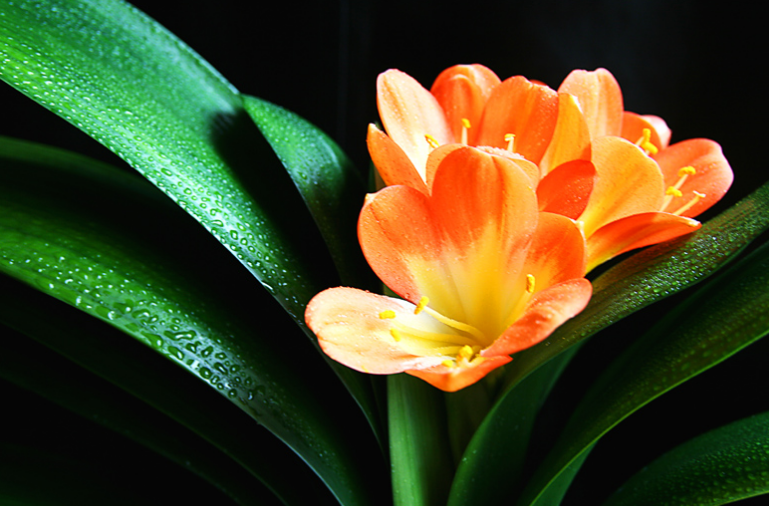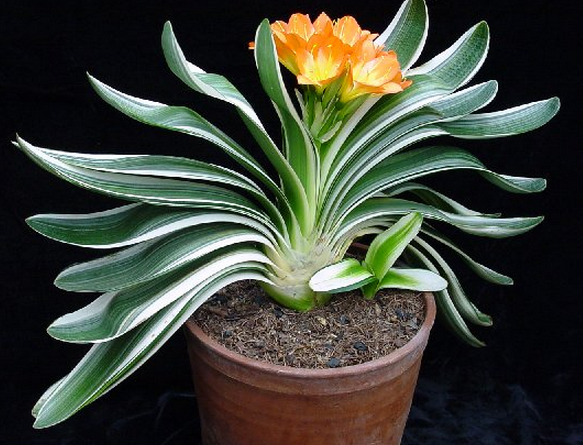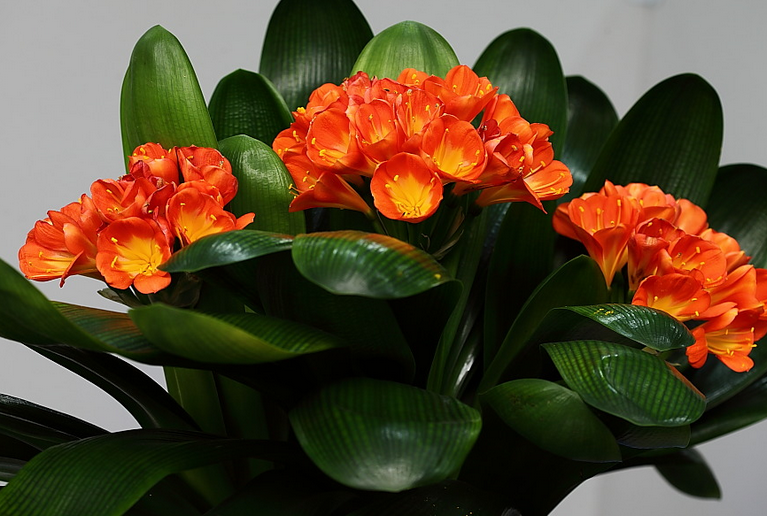Six steps of Cymbidium Culture in Summer
Magnolia is a famous greenhouse flower. There are two species introduced from Europe and Japan in China. The former flower is small and drooping, which is called laughing gentleman orchid, while the latter has large and upward flowers, which is called big flower gentleman orchid, which is the most common species cultivated at present. Now many people like to cultivate orchids, so how to raise orchids in summer because of the characteristics of the climate? Next, let the editor who decorates the network give you a brief introduction.

Six steps of Cymbidium Culture in Summer
1. Prevent direct sunlight and do not expose yourself to the sun
The magnolia in summer should cover the strong light all day. Using the oblique light of the sun for a while every morning is enough to satisfy photosynthesis.
2. Prevent high temperature, do not dry
The summer temperature of gentleman orchid is 18 ℃-25 ℃, it is best to put it in an air-conditioned room, or in a balcony shaded and ventilated place. When watering, it is best to use tap water that has been insolated for two or three days, and water once after 6 o'clock every afternoon, do not make the basin soil too dry or too wet.
3. Prevent apprentices from growing, do not apply fertilizer
Summer is the dormant period of Magnolia, stop fertilization, moderate watering, humidity control is an effective measure. If the pot soil is overfertilized or the fertilizer effect is large, the soil in the upper part of the flowerpot should be poured out and mixed with the sand of 1, 3, 2, 2 and 3, which can not only reduce the fertilizer effect, but also play a cooling role.
4. Prevent dust pollution and do not pour dirty water
The leaves of Cymbidium should be kept clean, dipped in water with fine gauze every week, wrung out and gently dabbed once. Pouring dirty water will cause the roots and leaves to rot and turn yellow.
5. prevent soil consolidation and do not use clay (loess) into the basin.
Cymbidium is suitable for cultivation in humus soil with loose, breathable, water-permeable, fertile and PH value of about 7.0.
6. Prevent diseases and do not get infected
When changing soil or wiping leaves, the action should be light to prevent the root leaves from breaking and flowing out of juice, causing infection to cause ulceration.
Culture methods and matters needing attention of Cymbidium
The gentleman's orchid can meet the needs of people in many aspects, such as beautifying the room, edifying sentiment, purifying the air, improving health and so on, make your room show the elegant style, and add luster and charm to enrich and regulate people's life. So what are the methods of raising magnolia? What are the points for attention? Next, let the editor who decorates the network give you a brief introduction.
Culture methods and matters needing attention of Cymbidium
The Culture method of Magnolia
1. Growth habits: to understand the breeding methods of Cymbidium, we must first know the growth habits of Cymbidium. Cymbidium is afraid of hot and cold-resistant plants, likes semi-shady and humid growth environment, and is afraid of direct sunlight. So Cymbidium generally grows under the tree. Its sound field is often suppressed, which is one of the reasons why it grows for a long time. The optimum growth temperature of Cymbidium is between 18 and 28 ℃. It is suitable for growing in fertile and fluffy soil.
2. Breeding methods: Magnolia was originally from under the big trees in the high-altitude forests of southern Africa. Like to be fertile, so when breeding magnolia, we should choose loose and fertile neutral or weakly acidic humus soil, which is composed of 65% humus soil, 20% net sand and 15% fine furnace ash as the best soil for cultivating magnolia. At the same time, it is best to ensure that the relative humidity of the orchid is about 40%.
Points for attention of gentleman orchid
1. As mentioned above, the habit of Cymbidium is shady, so when raising Cymbidium, be careful not to put it under the strong sun, and to ensure its best temperature, to control the best temperature of Cymbidium. Especially in summer and winter. Especially in summer, the magnolia should be prepared for the summer and cool down in time.
2. When raising Cymbidium, we should pay attention to keep the soil moist. So sprinkle water at any time, pay attention to not spraying too much at one time, generally spray water on the leaf surface. This method can also be used to cool down in summer. In addition, the magnolia itself likes to be fertile, so it needs to be fertilized from time to time.
The cultivation method of Strange Cymbidium is the sixth type of native species found in South Africa around 2000, and it is a national protected species of South Africa. It was found in the Northern Cape, South Africa. Magnolia grows in humus in cracks in the slopes of rocky mountains. They either live alone or live in groups. The areas where they grow generally have a semi-arid Mediterranean climate and often experience a period of precipitation in winter. Below, the editor of the net will introduce the breeding method of strange gentleman orchid.
Strange gentleman orchid picture strange gentleman orchid culture method
Planting
Pot cultivation can be made from a mixture of mature horse dung, rotten leaf soil, river sand or furnace ash, with a proportion of 6:3:1. The basin of the adult seedling should be changed every 2-3 years, and the size of the basin should be determined according to the seedling, and the soil should be changed when changing the basin.
Fertilizer application
Gentleman orchid likes fertilizer, but excessive fertilization is easy to rot roots, so it is appropriate to adopt the method of "thin fertilizer", do not apply thick fertilizer and "raw fertilizer". A thin fertilizer dominated by nitrogen was applied once in about 10 days in spring and autumn to promote the growth of branches and leaves. Apply phosphorus-based thin fertilizer once a week to speed up the arrow and make the flowers bright. When the temperature is above 30 ℃, the orchid is in the semi-dormant period, the growth stops below 10 ℃ and enters the dormant period, it is not suitable to apply fertilizer, and attention should be paid to keeping the basin soil dry.
In addition, the family should change the pot and soil every 1-2 years, which is not only conducive to timely supplement of basin soil nutrition, increase fertility, but also make the roots stretch, which is conducive to growth. The pot change should be carried out after flowering in spring or autumn.
Watering
Cymbidium has well-developed fleshy roots, too much watering is easy to rot roots, too little watering also affects the growth of new leaves, rooting and arrows.
The amount of water should be treated differently according to the specific situation. Those with small pots, high temperature, good ventilation, fast evaporation and good soil permeability should be watered more, and vice versa. Generally, less water is needed at the seedling stage and more at the flowering stage. There should be more watering in spring and summer, generally once a day, less in autumn and winter, 1-2 days in autumn and 4-5 days in winter.
Temperature, light
The suitable temperature for the growth of Cymbidium is 15-25 ℃. When the temperature is higher than 25 ℃, the plant growth is poor, and the excessive growth of leaves often occurs, which affects the flower bud differentiation. At this time, attention should be paid to ventilation and cooling; when the temperature is lower than 10 ℃, the growth is slow; when the temperature is below O ℃, the plant will freeze to death. In summer, we should pay attention to cooling, or choose cool mountains and other places to spend the summer to promote flower bud differentiation. We must guard against the cold in winter. The temperature difference between day and night is large, which is beneficial to the growth of Cymbidium, and the suitable range is 6-10 ℃.
Gentleman orchid prefers weak light to strong light, especially in summer, which can not be exposed to sunlight. The leaves of plants grown in 50% transparent environment are green and green, which can greatly improve the ornamental effect. Magnolia has a strong phototropism, so it is necessary to regularly turn the direction of the basin, so that the plant is evenly exposed to light, so that the elongation direction of the leaves in a line.
Pest control
The common pest of Cymbidium is shell insect. When insect pests occur, shell insects often gather on the tender shoots of leaves, absorb leaf juice, secrete a large number of bacteria, make stems and leaves become mildew black, cause soot disease, and make leaves wither. This insect has strong fecundity and can produce many generations a year. A female adult can often reproduce hundreds of larvae. If no control measures are taken in time, the whole plant will die.
Prevention and treatment methods: give priority to prevention. Usually, we should always pay attention to check the plant, find insect pests, control as soon as possible, in order to prevent spread. In addition to the control of shell insects, both artificial and drug can be used at the same time. If only 1-2 leaf tips are found, they can be scraped manually, sharpened with thin sticks or scraped off with bamboo cuttings. If there are a large number of nymphs, it can be sprayed with 1000 times of imidophos EC, or 40% omethoate emulsion plus 1000-1500 times water. Generally, it can be killed by spraying 1-2 times.
In addition, it should be noted that earthworms can also become pests of magnolia. In the young period of the orchid plant, its fleshy root is very weak. If there are earthworms in the basin soil, it will often drill everywhere, injuring the tender root, destroying the function of absorbing nutrition, stopping the growth and development of the plant or causing rotten root.
The method of prevention and control is to always pay attention to whether there are round soil particles (that is, earthworm excrement) on the surface of the basin soil, and if found, you can immediately irrigate it with 1500-2000 times of dichlorvos emulsion. When earthworms are found to drill after irrigation, they should be removed immediately, and once more after a week, the earthworms can be removed.
Shaping and pruning
Reproduction
Magnolia can be propagated by sowing or dividing plants.
For sowing, due to the low fruiting ability of self-pollination, artificial pollination is needed to obtain seeds, and the seeds can be sown after maturity. Sow the seed hole downward in a shallow basin, cover with sandy soil 1-1.5cm, pour water through, put it indoors, keep it 20-25 ℃ and the basin soil moist, and germinate in about 1 month. In the future, the moisture should be properly controlled and sufficient light should be given. General seedlings grow only 2 leaves in the first year.
Ramet, it is easy to produce tillers around the root neck of Cymbidium, commonly known as "foot buds", which can be used for reproduction. Ramet is usually carried out in combination with changing pots from March to April in spring. After the "foot buds" are separated from the mother plant, they are planted in plain sand to cultivate their roots. After about one month, they can produce small new roots, and then replant them.
Florescence regulation
Tips
[how does the gentleman orchid spend the summer safely]
The temperature in hot summer in many areas of China is more than 30 ℃. This environmental condition is not suitable for the normal growth of Cymbidium, which will cause overgrown leaves, thin and slender leaves, yellowing color, unclear veins, affecting ornamental value, and rotting roots in muggy weather. In order to make the orchid spend the summer safely, the following measures should be taken:
(1) shading and cooling: in summer, flowerpots can be placed behind the building or in the shade of big trees, or in the window of a well-ventilated and cool room facing north.
(2) increase air humidity: spread sand and sprinkle water on the ground inside the north balcony, put the flowerpot on the sand surface, or put a plank above the pool, which is filled with cold water, and put the flowerpot planted with magnolia on the plank, both can increase air humidity and reduce air temperature.
[solve the problem of "clamping arrows"]
Adult orchids pull out their pedicels before they bloom, commonly known as "pulling arrows". However, some plants in the growth and development, the pedicel is not extracted, the bud is formed, sandwiched in the pseudo-bulb, resulting in the phenomenon of "arrow clip". There are many reasons, such as: low room temperature (pot temperature), which is not conducive to pedicel cell division and elongation; insufficient nutrition during flowering, especially lack of phosphorus and potassium; basin soil consolidation, lack of permeability and insufficient watering, and so on. The solution is to appropriately increase the temperature of the basin soil, strengthen fertilizer and water management before flowering, and can also be treated with "Qijian Ling" drugs.
- Prev

Raise Cymbidium and lay a good Root of Cymbidium seedlings
When you do anything, you should lay a good foundation, and so is growing flowers. Take Cymbidium as an example. If you want Cymbidium to blossom and look good, you must make some efforts. You should cultivate it well from the beginning of its seedlings.
- Next

Magnolia has different culture methods in different seasons.
In ancient times, there were measures in accordance with local conditions, but now there are different breeding methods for different seasons. The flowers of Cymbidium are shaped like torches upward, orange-red, dignified and generous. They are ideal potted flowers for beautifying the environment. They are drooping, reserved, elegant and solemn, and have a lasting appeal.
Related
- Fuxing push coffee new agricultural production and marketing class: lack of small-scale processing plants
- Jujube rice field leisure farm deep ploughing Yilan for five years to create a space for organic food and play
- Nongyu Farm-A trial of organic papaya for brave women with advanced technology
- Four points for attention in the prevention and control of diseases and insect pests of edible fungi
- How to add nutrient solution to Edible Fungi
- Is there any good way to control edible fungus mites?
- Open Inoculation Technology of Edible Fungi
- Is there any clever way to use fertilizer for edible fungus in winter?
- What agents are used to kill the pathogens of edible fungi in the mushroom shed?
- Rapid drying of Edible Fungi

